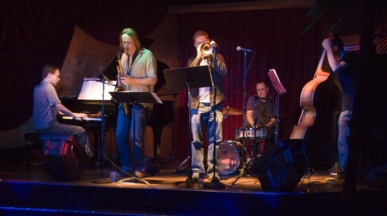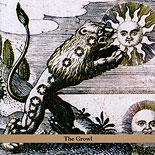I know mine was. With the quick distribution of music over the Web and other media, we are heading towards a Tower of Babel of sound. With technology, an enormous back catalogue, and almost no genre restrictions, musicians today celebrate almost unlimited freedom to bend, break, re-imagine, and dig up the old to pile on top of the new. We might not reach heaven, but we haven’t been knocked down yet. Just listen to the sound of the avant-garde coming out of New York. Is this jazz? Klezmer? Rock? Classical composition overlaid on top of a little psychedelia? CBGBs just closed, but iTunes has sold over a billion songs. Somewhere in the middle is a revolution. Starting this month, Zeek will be exploring this revolution, highlighting musicians, movements, and labels. Zeek will showcase a wide range of talent and styles, from folk to classical to rock to jazz, and will offer mp3s free for downloading. Zeek also encourages bands and musicians to submit their work for us to consider featuring at music[at]zeek.net. Peter Bebergal, Music Editor |
“Like the four seasons that come (and go), it is something that leaves something…” – Natan Zach
 Alon Nechustan, the leader of the band Talat, started his musical education with contemporary classical music. Today, even as it blends klezmer, jazz, middle-eastern and western grooves, Talat’s improvisation across genres works within the demands of disciplined composition, embodying a desire for music not to stand still, but to wrestle with history. It comments on what came before it the way that Stravinsky’s music critiques Mozart. In this case, Talat loves klezmer, but digs for its roots, sometimes finding the prayerful intentions that helped shaped the form. While klezmer is considered secular music in the formal sense, it borrows heavily from cantorial and liturgical practice. And even though contemporary klezmer emerged as an attempt to express life outside of the shul, the sounds of the shul are hard to shake off. In fact, a taste of the old school shul might even be part of what makes the music stick.
Alon Nechustan, the leader of the band Talat, started his musical education with contemporary classical music. Today, even as it blends klezmer, jazz, middle-eastern and western grooves, Talat’s improvisation across genres works within the demands of disciplined composition, embodying a desire for music not to stand still, but to wrestle with history. It comments on what came before it the way that Stravinsky’s music critiques Mozart. In this case, Talat loves klezmer, but digs for its roots, sometimes finding the prayerful intentions that helped shaped the form. While klezmer is considered secular music in the formal sense, it borrows heavily from cantorial and liturgical practice. And even though contemporary klezmer emerged as an attempt to express life outside of the shul, the sounds of the shul are hard to shake off. In fact, a taste of the old school shul might even be part of what makes the music stick.
Like the other new Jewish music worth paying attention to (and it’s no coincidence that Talat is recording with John’s Zorn’s Radical Jewish Culture imprint), Nechustan shapes klezmer with a fusion of other ancient and modern sounds. The song “Zah,” for example, blends drone, middle-eastern strings, and even a quiet echo of prog rock in an eight minute meditation. This particular track is one of several showing how music can often get closer to the dynamics of religious feeling than any other art form. “Zah” expresses a longing for an encounter with the holy wherever it may be found. Its mix of compositional and improvisational qualities make this sensibility so palpable – just as faith is often about both tradition and breaking with tradition, the foundation of the old and the radical promise of the new.  Despite his music’s strong inherited foundations, Nechustan struggles against it being claimed by any one tradition or historical moment. He says, “I feel that a lot of the time music can be used as a documentation of an era or preservation of a certain genre. I am trying to do the opposite and create a fresh environment that is relatively free from any demographical restrictions. Every tune is borrowing an idea, melody, groove, rhythm and trying to play or meditate about it, to illuminate it.” Illumination of simple musical ideas is the great function of improvisation, and it’s why so many contemporary (particularly avant-garde) Jewish musicians have likely found jazz forms to be such a valuable musical tools. Improvisation suggests something deep about being Jewish or notably “ethnic” or “other” in America, reminding us of the struggle between the echo of traditional forms and the siren call of modernity. Improv lets musicians bend and break each of these poles as much as they must in order to form a creative identity, however fluid and dynamic it might be.
Despite his music’s strong inherited foundations, Nechustan struggles against it being claimed by any one tradition or historical moment. He says, “I feel that a lot of the time music can be used as a documentation of an era or preservation of a certain genre. I am trying to do the opposite and create a fresh environment that is relatively free from any demographical restrictions. Every tune is borrowing an idea, melody, groove, rhythm and trying to play or meditate about it, to illuminate it.” Illumination of simple musical ideas is the great function of improvisation, and it’s why so many contemporary (particularly avant-garde) Jewish musicians have likely found jazz forms to be such a valuable musical tools. Improvisation suggests something deep about being Jewish or notably “ethnic” or “other” in America, reminding us of the struggle between the echo of traditional forms and the siren call of modernity. Improv lets musicians bend and break each of these poles as much as they must in order to form a creative identity, however fluid and dynamic it might be.
The musician calling upon improvisation may lead a melody through a variety of other forms, such as a chant, a groove, or even, in the case of Talat, an explosion of horns that sounds like a hundred shofars played by Ornette Coleman. But like klezmer, the jazz tradition demands that some of what a musician plays can be repeatable and teachable so that a new standard can be reinterpreted later.
At the root of Talat’s music are familiar rhythms and melodies such as klezmer niggunim or jazz phrasings. Of this choice, Nechustan explains, “When you hear something that stays and doesn’t go away it’s important. Some of these melodies I hear a lot because they just stick. If you can find anything in my music that ‘sticks’ it’s important even if it’s just for a day or two. And you might not even know it at the time.”
Talat’s album The Growl is available now on Tzadik.








I come across your webpage from cuil and it’s high quality. Thnkx for giving this sort of an incredible article..